Eglwys a Mynwent St. Deiniol Cemetery


Cyngor Cymuned
Llandderfel
Community Council
Cynghorau Penllyn Councils © 2025 Website designed and maintained by H G Web Designs
Cyfeirir at Eglwys Sant Deiniol fel Sant Môr ar fapiau Arolwg
Ordnans hanesyddol (1889-1901), ond nid oes cofnod arall o
Sant Môr felly credir mai camgymeriad oedd hwn,.
Adeiladwyd yr eglwys bresennol yn 1875 gan y pensaer E B
Ferrey, a gododd Eglwys Llanuwchllyn, hefyd, ond saif ar safle
eglwys hynaf Meirionnydd a fu unwaith yn gwasanaethu'r
plwyf mawr hwn. Mae gan yr eglwys garreg arysgrifendig o'r
chweched ganrif yn rhan o’i thŵr. Mae’r arysgrif wedi'i
gyfieithu fel 'Cavos, mab Seiargios,yn gorwedd yma'. Yn
hanesyddol roedd Llanfor yn cael ei hadnabod fel Llanfawr
(mae nifer o eiriau yn y Gymraeg lle mae’r deusain aw yn
newid yn o; dyma ddigwyddodd yma), ac mae'r enw'n
awgrymu canolfan eglwysig arwyddocaol ac o bosibl canolfan
fasnachol.
Mae agosrwydd gweddillion Rhufeinig, Cyfadeilad Milwrol
Rhufeinig Llanfor, yn dangos bod y lleoliad hwn wedi bod yn
arwyddocaol o ran setliad ers tro. Mae cylchfur canoloesol
gwrthglawdd Pen-ucha'r-llan, yn amlycaf ym mhen
gogleddol Llanfor. Mae'n edrych dros yr eglwys o safle uchel
tua 70m i'r gogledd. Efallai fod y ddau yn gyfoes ac wedi
cyfansoddi elfennau o'r un setliad. Caed ffynnon yma, a elwid
yn Ffynnon Deiniol rhyw 30m i'r gogledd ddwyrain o ffin y
fynwent, a dywedir y llifai’r dyfroedd i'r fynwent. Mae'r bryn,
Bryn Pader,sydd bellach yn enw fferm, tua 1km i'r gogledd
ddwyrain o'r eglwys. Honnir mai dyma'r safle y gwelai
teithwyr yr eglwys gyntaf ac adrodd eu Pater Noster.
Yn 1254 y ceir y cofnod cyntaf am yr eglwys. Soniwyd amdani
eto yn 1291, â gwerth trethiannol o £19, pan nodwyd Llawr-y-
bettws fel capelaeth ar gyrion plwyf Llanfor. Roedd yr eglwys
cynnar yn cynnwys corff a changell ddi-dor, tŵr gorllewinol,
capel gogleddol a phorth deheuol. Nodwyd bwa crwn rhwng
y tŵr a chorff yr eglwys, yn dynodi dyddiad o'r ddeuddegfed
ganrif. Mae’r ffaith fod gan yr eglwys dŵr o’r ddeuddegfed
ganrif yn arwydd o’i statws uchel bryd hynny. Ym 1913
cofnodwyd y bedyddfaen wythonglog cynharach yng ngardd
y rheithordy. Mae carreg yn nodi’r dyddiad 1599, a ail-osodwyd
yn y tŵr, yn priodoli adeiladu capel y gogledd i Cadwalader
Prys ap Robert o Neuadd Rhiwlas, Y Bala. Atgyweiriwyd capel
y gogledd yn 1755. Erys sylfeini capel y gogledd a’r porth
deheuolyn y fynwent gerllaw’r adeilad presennol.
Mae'r eglwys bresennol yn adeilad rhestredig Gradd II. Mae
wedi'i adeiladu o gerrig rwbel gydag addurniadau tywodfaen,
sy'n ymgorffori brics a theils Rhufeinig wedi'u hailddefnyddio
o Gyfadeilad Milwrol Rhufeinig Llanfor. Mae'r adeilad yn
cynnwys corff a changell barhaus gyda thŵr gorllewinol uchel
a festri gogledd-ddwyreiniol. Mae sgrin y gangell fodern yn
cynnwys darnau o groglen y credir sy'n dyddio i tua 1500.
Cofnodwyd Arfbais Frenhinol a nodwyd testunau gyda Moses
ac Aaron ar bedwar cynfas yn darlunio golygfeydd beiblaidd
ym 1729 yn hongian uwchben bwrdd cymwynasau. Mae'r
rhain bellach ar goll. Mae amryw o ffenestri gwybr lliw
trawiadol, gweler y lluniau isod. Caeodd adeilad yr eglwys ym
1992 a chafodd ei gwerthu, ynghyd a’r tŷ hers a mhorth y
fynwent, i’r berchnogion presennol yn 2014.
Trosglwyddwyd y fynwent i berchnogaeth y Cyngor Cymuned
yn 1925. Yn wreiddiol, tybir fod y fynwent ar ffurf gromliniol,
fely dangosir gan ei ffiniau gogleddol a gorllewinol. Lleolir y
brif fynedfa, porth y fynwent, ar y ffin ddeheuol. Mae tŷ hers yr
eglwys yn union y tu allan i ffin y fynwent.
Ym 1884 adeiladwyd mawsolewm yn hanner gogleddol y
fynwent gan deulu Rhiwlas, perchnogion tir y rhan fwyaf o
Lanfor. Er gwaethaf gwg Esgob Llanelwy, llwyddodd un o’r
teulu, y cymeriad lliwgar Richard John Lloyd Price, i gynnwys
pennill ar ei orweddfan yn datgan diolch i’r ceffyl a wnaeth
ffortiwn iddo yn Kempton Park.
As to my latter end I go,
To meet my Jubilee;
I bless the good horse Bendigo,
Who built this tomb for me.
Yn yr eithaf arall, ceir bedd Robert Williams, y Pandy, bardd ac
athro ac un o linach o feirdd ac emynwyr a fu’n cynnal
diwylliant traddodiadol Cymreig a Chymraeg. Mae’r Pandy
Isaf i’w weld ar draws yr afon ar y ffordd rhwng y Bala a
Llangynog. Robert Williams biau’r englyn enwog sydd yn
gorffen â’r llinell: Beibl i bawb o bobl y byd, a’n hatgoffa o
waith Thomas Charles, gweinidog yn y Bala, yn sefydlu’r
Gymdeithas Feiblau i ddarparu beiblau mewn miloedd o
ieithoedd drwy’r byd.
Ymysg y chwedlau sy’n gysylltiedig â’r eglwys a’i mynwent y
mae’r stori am Lyn y Geulan Goch, pan ddaw’r diafol i eglwys
Llanfor ar wedd gŵr bonheddig ond rhoir ef mewn sach yn y
diwedd a’i luchio am dragwyddoldeb i Lyn y Geulan Goch
sydd yn rhan o Afon Dyfrdwy, gerllaw. Wrth feddwl am Lanfor
a mwy o arswyd, dylid cofio’r broffwydoliaeth o wae sydd yn y
cwpled adnabyddus:
Y Bala aeth a’r Bala aiff,
A Llanfor aiff yn llyn.
St Deiniol's Church, is referred to as St Mor's on historic (1889-
1901) Ordnance Survey mapping, but there is no other record
of a St Mor so this is thought to have been an error. The
present church was built in 1875 by the architect E B Ferrey,
who also built Llanuwchllyn Church, but it stands on the site
of the oldest church in Merioneth which once served this
large parish. The church has a sixth century inscribed stone
built into its tower. It’s inscription has been translated as
'Cavos,son of Seiargios, lies here'. Llanfor was historically
known as Llanfawr, and the name suggests a significant
ecclesiastical and possibly commercial centre.
The proximity of the extensive Roman remains of Llanfor
Roman Military Complex show that this locality has long been
significant in terms of settlement. A medieval ringwork,
Pen-ucha'r-llan earthwork dominates the northern end of
Llanfor. It overlooks the church from an elevated position
some 70m north. The two may have been contemporary and
have constituted elements of the same settlement. A well,
reputedly known as Ffynnon Deiniol; St Deiniol's well, is
situated some 30m to the north-east of the churchyard
boundary, and its waters are said to have flowed into the
churchyard. The hill, Bryn-pader, now the name of a farm, is
some 1km to the north-east of the church. It is reputedly the
point at which travellers first saw the church and repeated
their Pater Noster.
The first documentary reference to the church was in 1254. It
was again mentioned in 1291, with a tax value of £19, when
Llawr-y-bettws was noted to be an outlying chapelry of
Llanfor parish.
The earlier church building consisted of a continuous nave
and chancel, west tower, north
chapel and south porch. A round arch was noted between the
tower and nave, indicating a twelfth century date. The fact
that the church had a twelfth century tower is indicative of its
high status at that time. In 1913 the earlier octagonal font was
noted in the rectory garden.
A date stone of 1599, re-set in the tower, attributes the
construction of the north chapel to Cadwalader Prys ap
Robert of Rhiwlas Hall, Bala.
The north chapel was repaired in 1755. The foundations of the
north chapel and south porch remain in the churchyard
adjacent to the present building.
The present church is a Grade II listed building, erected in
1875, on the footprint of the earlier one. It is constructed of
rubble stone with sandstone dressings, which incorporates
re-used Roman brick and tile from Llanfor Roman Military
Complex. The building consists of a continuous nave and
chancel with tall west tower and north-east vestry. The
modern chancel screen incorporates portions of rood screen
thought to date to around 1500. A Royal Coat of Arms was
noted with text of Moses and Aaron on four canvases
depicting biblical scenes in 1729 hanging above an alms
table. These are now lost. The church building closed in 1992
and was sold, along with its lychgate and hearse house, to the
current owners in 2014.
Ownership of the cemetery was transferred to the
Community Council in 1925.The churchyard may have
originally been curvilinear, as indicated by its curved north
and west boundaries. The main entrance is through a
lychgate in the south boundary. The hearse house belonging
to the church is situated immediately outside the churchyard
boundary.
In 1884 a mausoleum was built in the northern half of the
cemetery by the Rhiwlas family, landowners of most of
Llanfor. Despite the disapproval of the Bishop of St Asaph,
one of the family, the colourful character Richard John Lloyd
Price, managed to include a verse on its declaring thanks to
the horse that made him a fortune at Kempton Park.
As to my latter end I go,
To meet my Jubilee;
I bless the good horse Bendigo,
Who built this tomb for me.
There is also the grave of Robert Williams, Pandy, poet and
teacher and one of a line of poets and hymn writers who
maintained traditional Welsh culture and the Welsh
language. Pandy Isaf can be seen across the river on the road
between Bala and Llangynog. Robert Williams is the author
of the poem who ends with the line: A bible for all in the
world, and reminds us of the work of Thomas Charles, a
minister in Bala, who established the Bible Society to provide
bibles in thousands of languages through the world. Among
the legends associated with the church and its cemetery is
the story of Lyn y Geulan Goch, where the devil comes to
Llanfor church in the guise of a gentleman but he is put in a
sack and thrown away for eternity into Lyn y Geulan Goch
which is part of the nearby River Dee.
When thinking about Lanfor and more horror, one should
remember the prophecy of woe that is in the well-known
couplet:
The Bala went and the Bala goes,
And Llanfor goes into the lake.
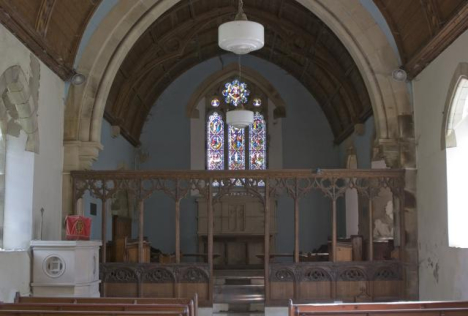
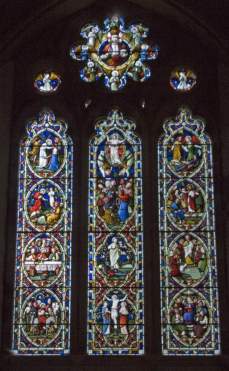
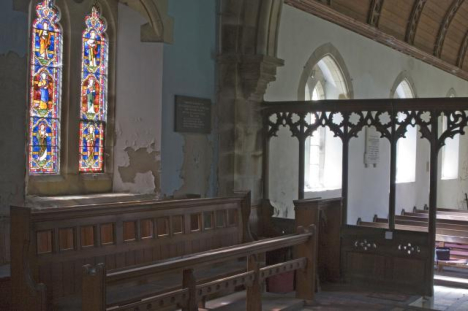
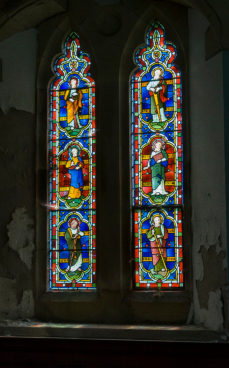

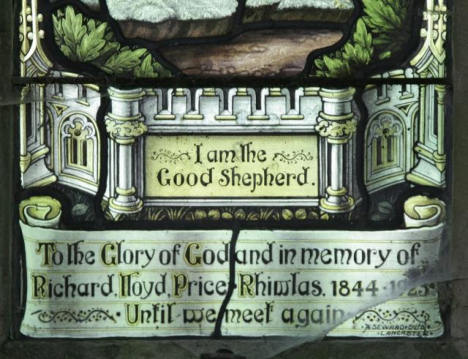
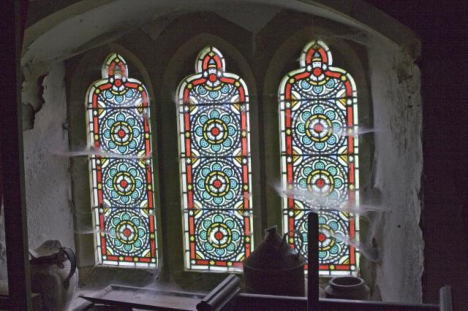
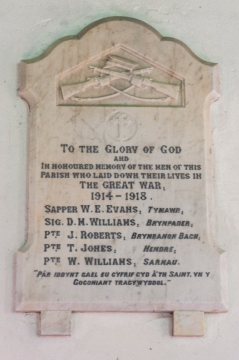
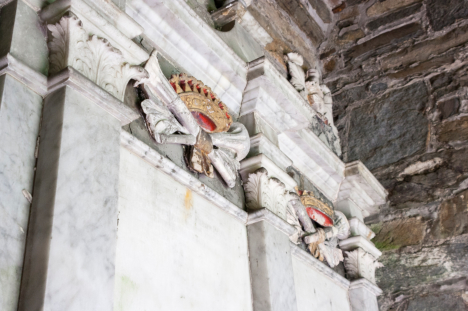
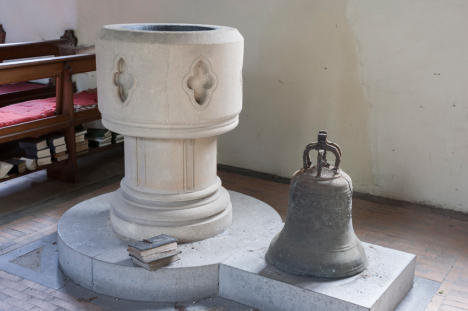
Lluniau/Photo’s © Martin Crampin
‘Stained Glass in Wales’ http://stainedglass.llgc.org.uk/site/325
https://www.martincrampin.co.uk
Gwydr patrymog, dyddiedig tua 1875. Festri.
Patterned Glass, dated aroud 1875. Vestry.
Crist y Bugail Da. A. Seward & Co, dyddiedig tua 1923. Mur gogleddol corff yr eglwys.
Christ the Good Shepherd. A. Seward & Co, dated around 1923. North wall of the nave.
Golygfeydd o Ddioddefaint ac Atgyfodiad Crist,a Deddfau yr Apostolion.
Lavers, Barraud & Westlake, dyddiedig 1875. Ffenestr tri golau, wal ddwyreiniol yr eglwys.
Scenes from the Passion and Resurrection of Christ, and the Acts of the Apostles.
Lavers, Barraud & Westlake, dated 1875. Three-light window, east wall of the church.
Y Deuddeg Apostol.Lavers, Barraud a Westlake, dyddiedig 1875. Wal ddeheuol y gangell.
The Twelve Apostles.Lavers, Barraud & Westlake, dated 1875. South wall of the chancel.
Eglwys a Mynwent St. Deiniol Cemetery

Cyngor Cymuned
Llandderfel
Community Council
Cynghorau Penllyn Councils © 2025
Website designed and maintained by H G Web Designs
Cyfeirir at Eglwys Sant Deiniol fel Sant Môr ar fapiau Arolwg
Ordnans hanesyddol (1889-1901), ond nid oes cofnod arall o
Sant Môr felly credir mai camgymeriad oedd hwn,.
Adeiladwyd yr eglwys bresennol yn 1875 gan y pensaer E B
Ferrey, a gododd Eglwys Llanuwchllyn, hefyd, ond saif ar safle
eglwys hynaf Meirionnydd a fu unwaith yn gwasanaethu'r
plwyf mawr hwn. Mae gan yr eglwys garreg arysgrifendig o'r
chweched ganrif yn rhan o’i thŵr. Mae’r arysgrif wedi'i
gyfieithu fel 'Cavos, mab Seiargios,yn gorwedd yma'. Yn
hanesyddol roedd Llanfor yn cael ei hadnabod fel Llanfawr
(mae nifer o eiriau yn y Gymraeg lle mae’r deusain aw yn
newid yn o; dyma ddigwyddodd yma), ac mae'r enw'n
awgrymu canolfan eglwysig arwyddocaol ac o bosibl canolfan
fasnachol.
Mae agosrwydd gweddillion Rhufeinig, Cyfadeilad Milwrol
Rhufeinig Llanfor, yn dangos bod y lleoliad hwn wedi bod yn
arwyddocaol o ran setliad ers tro. Mae cylchfur canoloesol
gwrthglawdd Pen-ucha'r-llan, yn amlycaf ym mhen
gogleddol Llanfor. Mae'n edrych dros yr eglwys o safle uchel
tua 70m i'r gogledd. Efallai fod y ddau yn gyfoes ac wedi
cyfansoddi elfennau o'r un setliad. Caed ffynnon yma, a elwid
yn Ffynnon Deiniol rhyw 30m i'r gogledd ddwyrain o ffin y
fynwent, a dywedir y llifai’r dyfroedd i'r fynwent. Mae'r bryn,
Bryn Pader,sydd bellach yn enw fferm, tua 1km i'r gogledd
ddwyrain o'r eglwys. Honnir mai dyma'r safle y gwelai
teithwyr yr eglwys gyntaf ac adrodd eu Pater Noster.
Yn 1254 y ceir y cofnod cyntaf am yr eglwys. Soniwyd amdani
eto yn 1291, â gwerth trethiannol o £19, pan nodwyd Llawr-y-
bettws fel capelaeth ar gyrion plwyf Llanfor. Roedd yr eglwys
cynnar yn cynnwys corff a changell ddi-dor, tŵr gorllewinol,
capel gogleddol a phorth deheuol. Nodwyd bwa crwn rhwng
y tŵr a chorff yr eglwys, yn dynodi dyddiad o'r ddeuddegfed
ganrif. Mae’r ffaith fod gan yr eglwys dŵr o’r ddeuddegfed
ganrif yn arwydd o’i statws uchel bryd hynny. Ym 1913
cofnodwyd y bedyddfaen wythonglog cynharach yng ngardd
y rheithordy. Mae carreg yn nodi’r dyddiad 1599, a ail-osodwyd
yn y tŵr, yn priodoli adeiladu capel y gogledd i Cadwalader
Prys ap Robert o Neuadd Rhiwlas, Y Bala. Atgyweiriwyd capel
y gogledd yn 1755. Erys sylfeini capel y gogledd a’r porth
deheuolyn y fynwent gerllaw’r adeilad presennol.
Mae'r eglwys bresennol yn adeilad rhestredig Gradd II. Mae
wedi'i adeiladu o gerrig rwbel gydag addurniadau tywodfaen,
sy'n ymgorffori brics a theils Rhufeinig wedi'u hailddefnyddio
o Gyfadeilad Milwrol Rhufeinig Llanfor. Mae'r adeilad yn
cynnwys corff a changell barhaus gyda thŵr gorllewinol uchel
a festri gogledd-ddwyreiniol. Mae sgrin y gangell fodern yn
cynnwys darnau o groglen y credir sy'n dyddio i tua 1500.
Cofnodwyd Arfbais Frenhinol a nodwyd testunau gyda Moses
ac Aaron ar bedwar cynfas yn darlunio golygfeydd beiblaidd
ym 1729 yn hongian uwchben bwrdd cymwynasau. Mae'r
rhain bellach ar goll. Mae amryw o ffenestri gwybr lliw
trawiadol, gweler y lluniau isod. Caeodd adeilad yr eglwys ym
1992 a chafodd ei gwerthu, ynghyd a’r tŷ hers a mhorth y
fynwent, i’r berchnogion presennol yn 2014.
Trosglwyddwyd y fynwent i berchnogaeth y Cyngor Cymuned
yn 1925. Yn wreiddiol, tybir fod y fynwent ar ffurf gromliniol,
fely dangosir gan ei ffiniau gogleddol a gorllewinol. Lleolir y
brif fynedfa, porth y fynwent, ar y ffin ddeheuol. Mae tŷ hers yr
eglwys yn union y tu allan i ffin y fynwent.
Ym 1884 adeiladwyd mawsolewm yn hanner gogleddol y
fynwent gan deulu Rhiwlas, perchnogion tir y rhan fwyaf o
Lanfor. Er gwaethaf gwg Esgob Llanelwy, llwyddodd un o’r
teulu, y cymeriad lliwgar Richard John Lloyd Price, i gynnwys
pennill ar ei orweddfan yn datgan diolch i’r ceffyl a wnaeth
ffortiwn iddo yn Kempton Park.
As to my latter end I go,
To meet my Jubilee;
I bless the good horse Bendigo,
Who built this tomb for me.
Yn yr eithaf arall, ceir bedd Robert Williams, y Pandy, bardd ac
athro ac un o linach o feirdd ac emynwyr a fu’n cynnal
diwylliant traddodiadol Cymreig a Chymraeg. Mae’r Pandy
Isaf i’w weld ar draws yr afon ar y ffordd rhwng y Bala a
Llangynog. Robert Williams biau’r englyn enwog sydd yn
gorffen â’r llinell: Beibl i bawb o bobl y byd, a’n hatgoffa o
waith Thomas Charles, gweinidog yn y Bala, yn sefydlu’r
Gymdeithas Feiblau i ddarparu beiblau mewn miloedd o
ieithoedd drwy’r byd.
Ymysg y chwedlau sy’n gysylltiedig â’r eglwys a’i mynwent y
mae’r stori am Lyn y Geulan Goch, pan ddaw’r diafol i eglwys
Llanfor ar wedd gŵr bonheddig ond rhoir ef mewn sach yn y
diwedd a’i luchio am dragwyddoldeb i Lyn y Geulan Goch
sydd yn rhan o Afon Dyfrdwy, gerllaw. Wrth feddwl am Lanfor
a mwy o arswyd, dylid cofio’r broffwydoliaeth o wae sydd yn y
cwpled adnabyddus:
Y Bala aeth a’r Bala aiff,
A Llanfor aiff yn llyn.
St Deiniol's Church, is referred to as St Mor's on historic (1889-
1901) Ordnance Survey mapping, but there is no other record
of a St Mor so this is thought to have been an error. The
present church was built in 1875 by the architect E B Ferrey,
who also built Llanuwchllyn Church, but it stands on the site
of the oldest church in Merioneth which once served this
large parish. The church has a sixth century inscribed stone
built into its tower. It’s inscription has been translated as
'Cavos,son of Seiargios, lies here'. Llanfor was historically
known as Llanfawr, and the name suggests a significant
ecclesiastical and possibly commercial centre.
The proximity of the extensive Roman remains of Llanfor
Roman Military Complex show that this locality has long been
significant in terms of settlement. A medieval ringwork,
Pen-ucha'r-llan earthwork dominates the northern end of
Llanfor. It overlooks the church from an elevated position
some 70m north. The two may have been contemporary and
have constituted elements of the same settlement. A well,
reputedly known as Ffynnon Deiniol; St Deiniol's well, is
situated some 30m to the north-east of the churchyard
boundary, and its waters are said to have flowed into the
churchyard. The hill, Bryn-pader, now the name of a farm, is
some 1km to the north-east of the church. It is reputedly the
point at which travellers first saw the church and repeated
their Pater Noster.
The first documentary reference to the church was in 1254. It
was again mentioned in 1291, with a tax value of £19, when
Llawr-y-bettws was noted to be an outlying chapelry of
Llanfor parish.
The earlier church building consisted of a continuous nave
and chancel, west tower, north
chapel and south porch. A round arch was noted between the
tower and nave, indicating a twelfth century date. The fact
that the church had a twelfth century tower is indicative of its
high status at that time. In 1913 the earlier octagonal font was
noted in the rectory garden.
A date stone of 1599, re-set in the tower, attributes the
construction of the north chapel to Cadwalader Prys ap
Robert of Rhiwlas Hall, Bala.
The north chapel was repaired in 1755. The foundations of the
north chapel and south porch remain in the churchyard
adjacent to the present building.
The present church is a Grade II listed building, erected in
1875, on the footprint of the earlier one. It is constructed of
rubble stone with sandstone dressings, which incorporates
re-used Roman brick and tile from Llanfor Roman Military
Complex. The building consists of a continuous nave and
chancel with tall west tower and north-east vestry. The
modern chancel screen incorporates portions of rood screen
thought to date to around 1500. A Royal Coat of Arms was
noted with text of Moses and Aaron on four canvases
depicting biblical scenes in 1729 hanging above an alms
table. These are now lost. The church building closed in 1992
and was sold, along with its lychgate and hearse house, to the
current owners in 2014.
Ownership of the cemetery was transferred to the
Community Council in 1925.The churchyard may have
originally been curvilinear, as indicated by its curved north
and west boundaries. The main entrance is through a
lychgate in the south boundary. The hearse house belonging
to the church is situated immediately outside the churchyard
boundary.
In 1884 a mausoleum was built in the northern half of the
cemetery by the Rhiwlas family, landowners of most of
Llanfor. Despite the disapproval of the Bishop of St Asaph,
one of the family, the colourful character Richard John Lloyd
Price, managed to include a verse on its declaring thanks to
the horse that made him a fortune at Kempton Park.
As to my latter end I go,
To meet my Jubilee;
I bless the good horse Bendigo,
Who built this tomb for me.
There is also the grave of Robert Williams, Pandy, poet and
teacher and one of a line of poets and hymn writers who
maintained traditional Welsh culture and the Welsh
language. Pandy Isaf can be seen across the river on the road
between Bala and Llangynog. Robert Williams is the author
of the poem who ends with the line: A bible for all in the
world, and reminds us of the work of Thomas Charles, a
minister in Bala, who established the Bible Society to provide
bibles in thousands of languages through the world. Among
the legends associated with the church and its cemetery is
the story of Lyn y Geulan Goch, where the devil comes to
Llanfor church in the guise of a gentleman but he is put in a
sack and thrown away for eternity into Lyn y Geulan Goch
which is part of the nearby River Dee.
When thinking about Lanfor and more horror, one should
remember the prophecy of woe that is in the well-known
couplet:
The Bala went and the Bala goes,
And Llanfor goes into the lake.










Lluniau/Photo’s © Martin Crampin
‘Stained Glass in Wales’ http://stainedglass.llgc.org.uk/site/325
https://www.martincrampin.co.uk
Gwydr patrymog, dyddiedig tua 1875. Festri.
Patterned Glass, dated aroud 1875. Vestry.
Crist y Bugail Da. A. Seward & Co, dyddiedig tua
1923. Mur gogleddol corff yr eglwys.
Christ the Good Shepherd. A. Seward & Co, dated
around 1923. North wall of the nave.
Golygfeydd o Ddioddefaint ac Atgyfodiad Crist,a Deddfau yr
Apostolion.
Lavers, Barraud & Westlake, dyddiedig 1875. Ffenestr tri golau,
wal ddwyreiniol yr eglwys.
Scenes from the Passion and Resurrection of Christ, and the Acts of
the Apostles.
Lavers, Barraud & Westlake, dated 1875. Three-light window, east wall
of the church.
Y Deuddeg Apostol.Lavers, Barraud a Westlake, dyddiedig 1875.
Wal ddeheuol y gangell.
The Twelve Apostles.Lavers, Barraud & Westlake, dated 1875. South
wall of the chancel.















